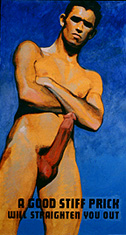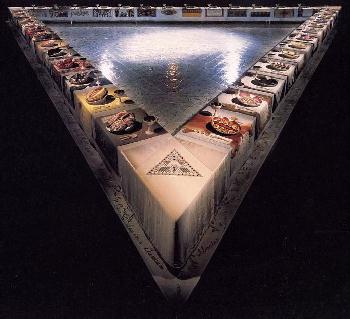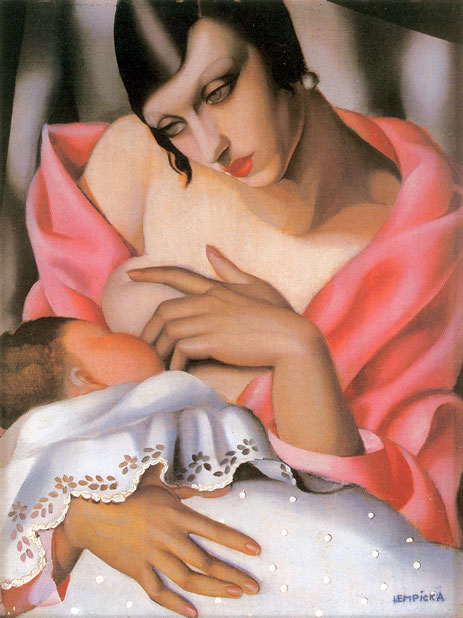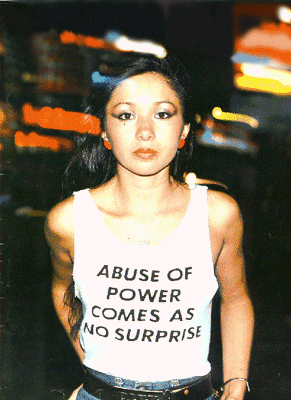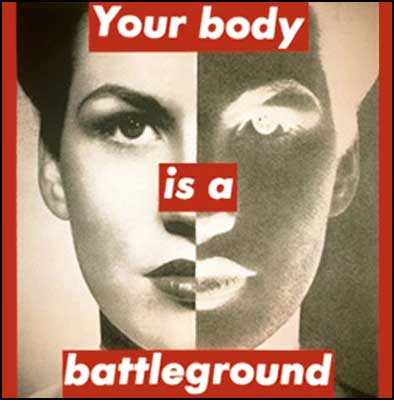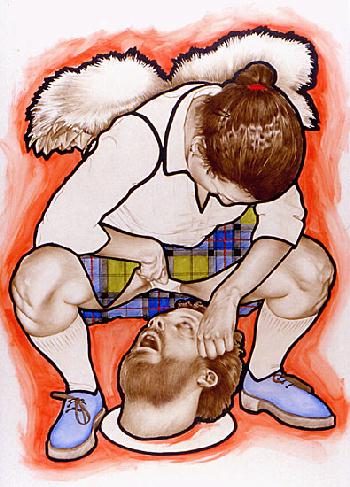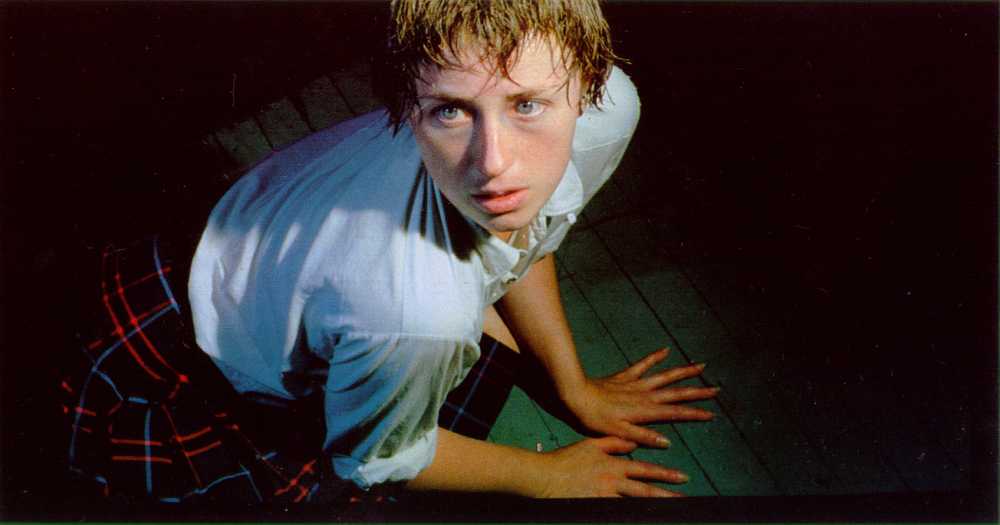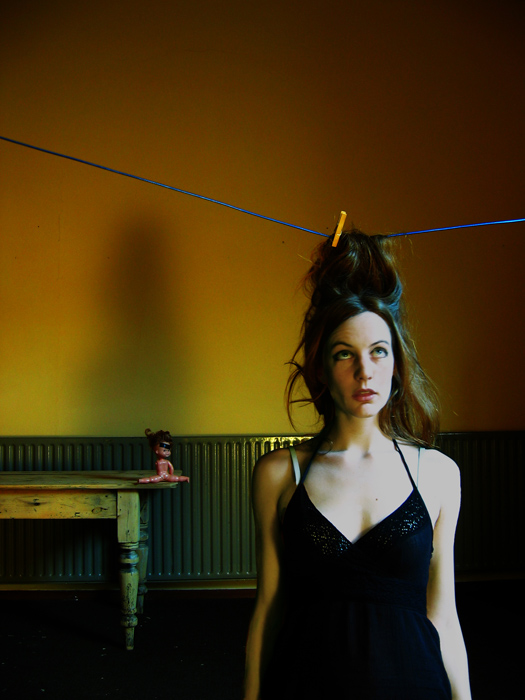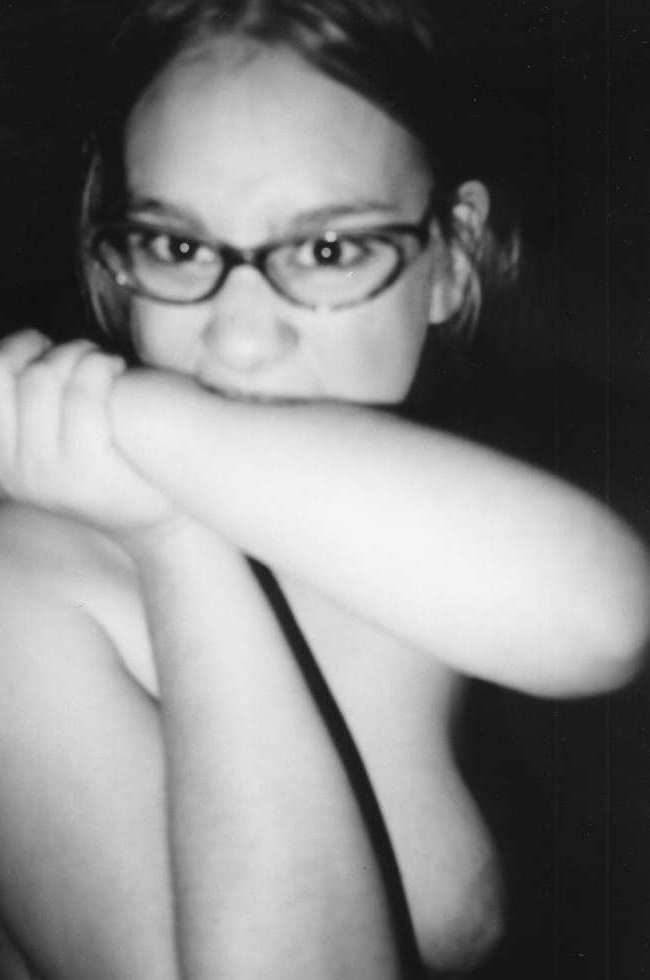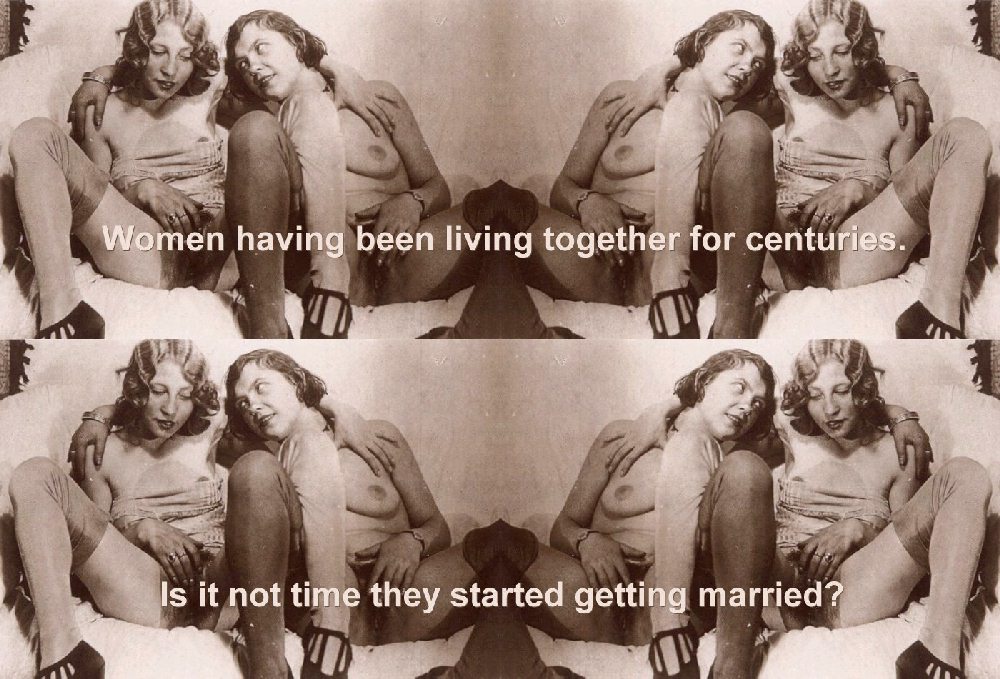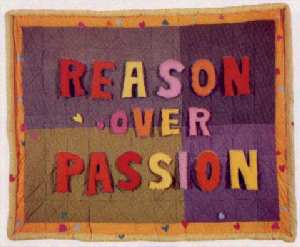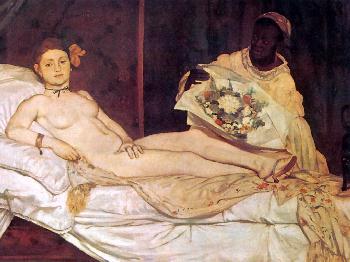| Feminist Art Practices & Political Art The Art History Archive - Feminist Art
Feminism in Artistic Theory & Practice
Lilith AdlerPainter Lilith Adler (born 1961 - died 2000) enjoyed combining text and graphic images of violence, sexuality and religion. Her primary method was to provoke the viewer with something graphic and use text to complete the message. Her 1996 piece Enforcement/Prick was a comment on her own sexuality as a lesbian and how some males think "a good stiff prick" will turn lesbians into penis-loving heterosexuals. Much of Lilith Adler's work deals with religious practices that push women down and try to keep them controlled. A few of her pieces also tackle racism, showing her interest in political topics in general.
Eleanor AntinPerformance and installation artist Eleanor Antin enjoys using metaphors and allegory. In her 2001-2002 series "The Last Days of Pompeii" she created a series of images that portray recreate Pompeii as an allegory for America's own greed, lust and over-consumption. To some extent women in America are treated more as visual commodities, in the advertising business, in Hollywood and even in relationships. "Frank O’Hara said once that he loved Marilyn Monroe. Protect us from such love! If Monroe hadn’t had yellow teeth or if her body hadn’t been deformed, would he have loved her then?" - Eleanor Antin. Below: Eleanor Antin - The Artist's Studio - 2001.
Judy ChicagoJudy Chicago is more infamous than famous. Her 1974-1979 work "The Dinner Party" used hundreds of unpaid and uncredited volunteers is a large triangular table with 39 plates representing the vaginas of 39 historical and mythological female guests of honour. The work is intended to elevate the 39 women to the level of heroes. Judy Chicago's poor and dehumanizing treatment of her volunteer workers have left her with a tarnished reputation such that a representative of the Guerrilla Girls once said "We just didn't want any more Judy Chicagos. No more monsters." Such was infamy of Judy Chicago's monumental piece that is spent decades in storage before finding a permanent home at the Elizabeth A Sackler Center for Feminist Art.
Tamara De LempickaArt deco painter Tamara De Lempicka (born 1898 - died 1980) was incredibly popular for her portraiture work during the 1920s but it was her later works like The Refugees in 1937 and Breastfeeding ( date unknown) which have led us to believe that her feminist work deserves more recognition for her more political and controversial topics. Painting a woman breastfeeding wasn't normal for women artists in her time period, but she defied norms as she painted nude women frequently. Tamara De Lempicka portrays women as being quite muscular. The angular style of works like Le Modele and Andromeda show women with both muscular power and physique, despite the fact that Andromeda is chained to the ground awaiting a sea monster. As a person Tamara De Lempicka had relationships with both men and women, seeming to favour the latter despite two marriages to wealthy affluent men. Her 1932 painting Adam and Eve suggests a healthy appetite for both the male and female form.
Jenny HolzerText and installation artist Jenny Holzer uses phrases plastered or projected over walls, buildings and even people to get her message across. She frequently uses electronic text displays to show strange and unusual phrases or "Truisms". Her messages aren't just meant for women, but for all of society to make people think.
Examples of Truisms
ABUSE OF POWER COMES AS NO SURPRISE
Barbara KrugerAnother text and installation artist is Barbara Kruger, but she mixes photography with text (the text is typically white on a red background) to create meaningful messages. Both Barbara Kruger and Jenny Holzer could be considered "Slogan Artists". Barbara Kruger's work frequently deals with consumerism in pieces like "I Shop Therefore I Am" and female domestic life in works like "It's a Small World But Not If You Have to Clean It". Trained as a graphic designer and working in the magazine industry for years it is no surprise that Barbara Kruger's work feels a bit like tailor-made advertising too, but the message is very different from the message of consumption typically found in magazine ads.
Jennifer LintonMixed media artist Jennifer Linton combines drawing, painting and found objects like cigarette wrappers to create unusual images often relating to mythology, religion and both historical & modern women. In her 2002 piece Salomé she portrays herself as a Catholic School Girl with the decapitated head of John the Baptist. Paintings of Salomé are popular in Christian art, typically portraying Salomé as nude or partially nude with the decapitated head, suggesting a strange fetish for bodies parts. Jennifer Linton has taken this fetish and combined it with the more modern Catholic School Girl fetish to create a warped statement on the nature of fetish and how we portray fetish. Jennifer Linton frequently combines sex and religion in her works, like her 1999 piece St. Agatha I or her 2005 piece Catholic Girls. |
|
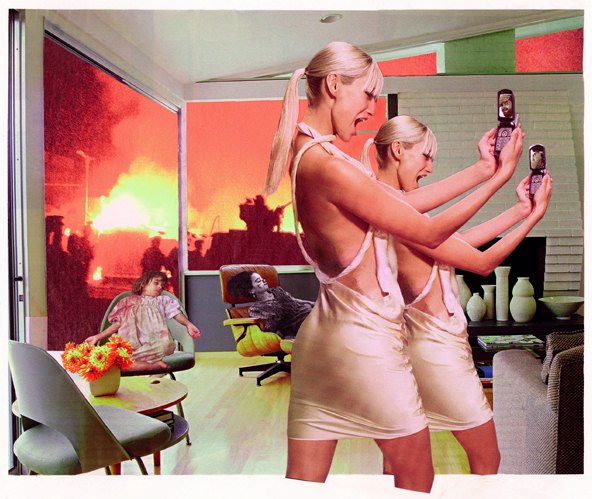
Martha RoslerMartha Rosler uses a variety of mediums, but her most recognizable medium is photo-collage and photo-text. She also works creates video installations and performance art. Her work frequently contrasts the domestic lives of women with international war, repression and politics, and pays close attention to the mass media and architectural structures. In the example shown here she contrasts America's consumer culture with our overseas agenda of war and extortion. Her goal is to push home the realities of war while pushing at the same time against the domestic lives of women. Below: Martha Rosler - Saddam's Palace (Febreze) - 2004. 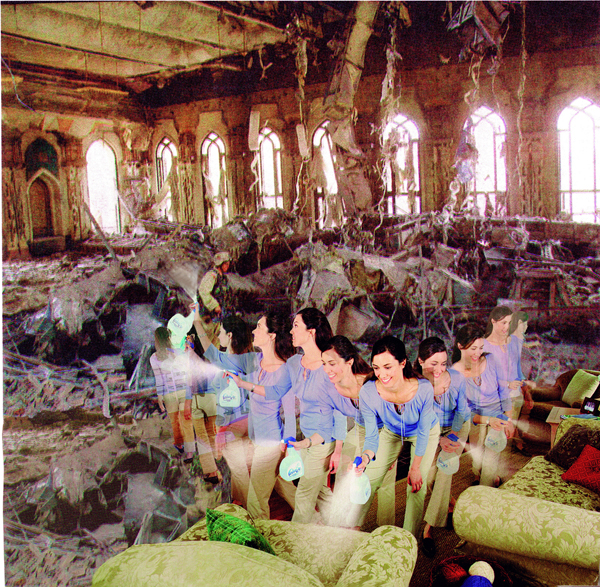
Cindy ShermanPhotographer Cindy Sherman uses a combination of self-portraits, dolls, fake body parts and make up to create a variety of strange and often obscene images. Her modern work attempts to shock the viewer with strange imagery while her older works from the 1970s was a mockery of Hollywood film stills. Cindy Sherman frequently uses, distorts and messes with archetypes and stereotypes of women and their portrayal in mass media and art. Untitled #92 (right) is a mockery of how women are portrayed in men's magazines.
Rachel StonePhotographer Rachel Stone also works with similar methods to Cindy Sherman, using both self-portraiture and dolls. Stone's work is more distinctly feminist however as it frequently deals with the domestic lives of women, pregnancy and motherhood. She frequently uses props such as phones, dolls, tea pots, clothing pins and other items identified with the domestic lives of women. Her collection of plastic dolls frequently makes an appearance in her work either in the foreground like in her 2006 piece "Drain Me" or cleverly hidden in the background. In Rachel Stone's 2006 piece "Hanged Self" for example a doll is seen in the background doing the splits on the wooden table while Rachel Stone contemplates hanging herself with a clothing pin. Surrealism plays a major role in Rachel Stone's work as she uses nightmares and dreamscapes to create images that are unusual. Unlike Cindy Sherman who uses pure photography to create her images, Rachel Stone will also sometimes photoshop her work to create strange images not possible with a camera.
Victoria Van Dyke
Photographer and collage artist Victoria Van Dyke takes weirdness and obscenity to a whole new level. Sexually abused and raped while still in her youth Van Dyke has taken her past and transformed her work over time into a sarcastic and biting shot at the status quo. She combines religion, violence, guns, sexuality and humour in images (sometimes with text) in order to poke fun at society, society's obsession with sex, and the patriarchal treatment of young underage women as sex objects. Her older work is rather bizarre, combining an unusual belief in cannibalism, amazonism and raw sexuality in works like her 2001 pieces Cannibal #2 and I Want to be an Amazon. During 2006 Van Dyke started creating digital collages using vintage erotica, old postcards, pornography, photos of guns, flags, etc to create a new series called "Guns, Sex and Jesus". In the work she pokes fun at American patriotism, gun culture, obsession with sex symbols and homophobia. Below: Victoria Van Dyke - Marriage - 2007.
Joyce WielandMixed media artist and painter Joyce Wieland pioneered women's crafts like quilting at art pieces like in her 1968 piece "Reason Over Passion" (which hung in former Canadian Prime Minister Pierre Trudeau's 24 Sussex home while he was in office). Unlike Judy Chicago above Joyce Wieland always paid her workers and created a whole series of quilts as art pieces, frequently using text to get a broader message across. Joyce Wieland's paintings were more an expression of her relationships and her sexuality, with one piece showing a female kicking her male assailant in the crotch (see her 1984 piece Paint Phantom). Joyce Wieland also directed the 1976 film "The Far Shore", which depicts an allegorical story of the death of Canadian painter Tom Thomson (whose body was never found and presumed drowned).
The Male Gaze and the Female GazeThe male gaze is all about looking through the eyes of the heterosexual man. The theory was first talked about in Laura Mulvey's essay "Visual Pleasure and Narrative Cinema" in which she looks at the portrayal of women and how they are viewed in film, with the camera lingering on a female's physical curves and attributes. The same concept has since been applied by many feminists with respect to women in art, sexuality in advertising and the treatment of women in male-dominated pornography. Part of the idea is about how the viewer is treated as superior, as the viewer has the power to look and see everything. Women in paintings and art rarely look straight back at the viewer unless it is a portrait, and even so numerous portraits show women looking to the side or down in a demure fashion. Paintings like Edouard Manet's "Olympia" in 1865 and "The Bar at the Folies-Bergčre" in 1881 break from that mould, and during that time period sparked controversy. Prior to Manet most images of women looked away from the viewer and thus had an unequal power relationship. Other examples of the Female Gaze in art is Pierre Auguste Renoir's The Loge in 1874 and Mary Cassatt's At the Opera in 1879, because in both cases the women are actively looking at something and thus have an equal power with the viewer.
| |
